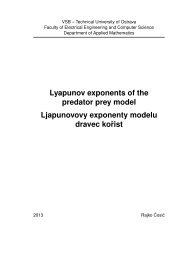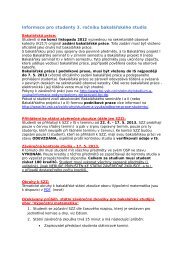The Boundary Element Method for the Helmholtz Equation ... - FEI VÅ B
The Boundary Element Method for the Helmholtz Equation ... - FEI VÅ B
The Boundary Element Method for the Helmholtz Equation ... - FEI VÅ B
You also want an ePaper? Increase the reach of your titles
YUMPU automatically turns print PDFs into web optimized ePapers that Google loves.
34 3 <strong>Boundary</strong> Integral <strong>Equation</strong>sAgain, <strong>the</strong> hypersingular operator is linear and <strong>the</strong>re exists a constant c ∈ R + such that∥D κ t∥ H −1/2 (∂Ω) ≤ c∥t∥ H 1/2 (∂Ω)<strong>for</strong> all t ∈ H 1/2 (∂Ω).<strong>The</strong> hypersingular operator cannot be represented in <strong>the</strong> same way as <strong>the</strong> precedingoperators. For D κ t with a smooth enough density function t we have(D κ t)(x) = −γ 1 (W κ t)(x) = − limΩ∋˜x→x∈∂Ω ⟨n(x), ∇˜x(W κ t)(˜x)⟩.Recall, that <strong>for</strong> <strong>the</strong> double layer potential we have <strong>the</strong> representation∂v κ(W κ t)(˜x) = (˜x, y)t(y) ds y∂Ω ∂n y= 1 ⟨˜x − y, n(y)⟩e iκ∥˜x−y∥ 14π∥˜x − y∥ 3 − iκ∥˜x − y∥ 2 t(y) ds y .∂ΩInterchanging <strong>the</strong> limit with <strong>the</strong> computation of <strong>the</strong> normal derivative we obtainlim (W κt)(˜x)Ω∋˜x→x∈∂Ω= 14π lim⟨x − y, n(y)⟩eε→0 +y∈∂Ω iκ∥x−y∥ : ∥x−y∥≥εBy computing <strong>the</strong> normal derivative of <strong>the</strong> integrand we get1∥x − y∥ 3 −(D κ t)(x) = 14π lime⟨n(y),ε→0 +y∈∂Ω iκ∥x−y∥ n(x)⟩: ∥x−y∥≥ε+ ⟨x − y, n(y)⟩⟨x − y, n(x)⟩3∥x − y∥ 5 −iκ∥x − y∥ 2 t(y) ds y .iκ∥x − y∥ 2 − 1∥x − y∥ 33iκ∥x − y∥ 4 − κ 2 ∥x − y∥ 3 t(y) ds y . (3.13)Un<strong>for</strong>tunately, <strong>for</strong> ε → 0 + <strong>the</strong> integrand from (3.13) is not an integrable function. To expressD κ t explicitly we need some regularization procedure. For <strong>the</strong> Galerkin discretizationof <strong>the</strong> boundary integral equations we need to evaluate <strong>the</strong> bilinear <strong>for</strong>m⟨D κ t, s⟩ ∂Ω := (D κ t)(x)s(x) ds x∂Ωinduced by <strong>the</strong> hypersingular operator. <strong>The</strong> following <strong>the</strong>orem gives us a representationusing surface curl operators.<strong>The</strong>orem 3.14. For functions s, t ∈ H 1/2 (∂Ω) <strong>the</strong>re holds <strong>the</strong> representation∂Ω(D κ t)(x)s(x) ds x = 1 4π− κ24π∂Ω∂Ω∂Ω∂Ωe iκ∥x−y∥∥x − y∥ ⟨curl ∂Ω t(y), curl ∂Ω s(x)⟩ ds y ds xe iκ∥x−y∥∥x − y∥ t(y)s(x)⟨n(x), n(y)⟩ ds y ds x









